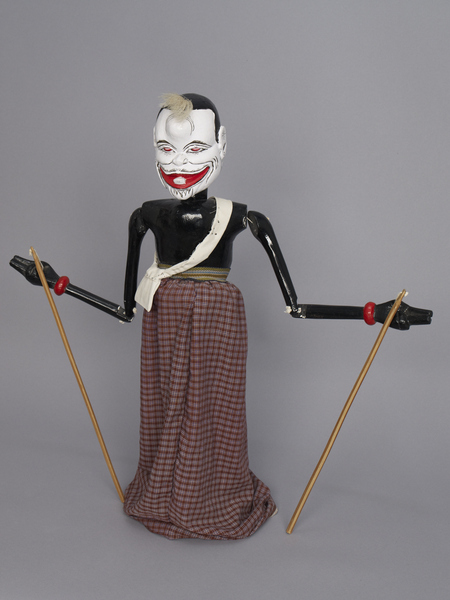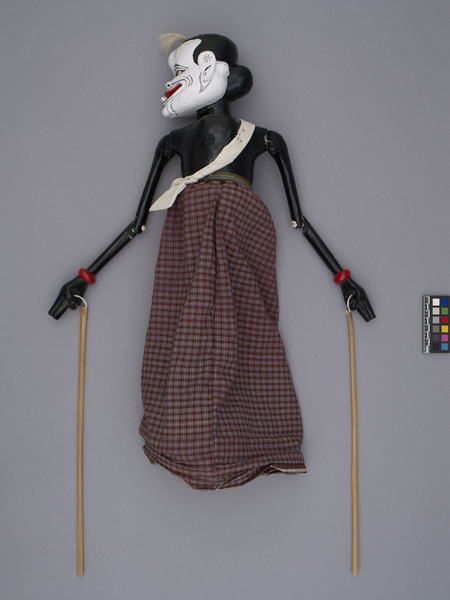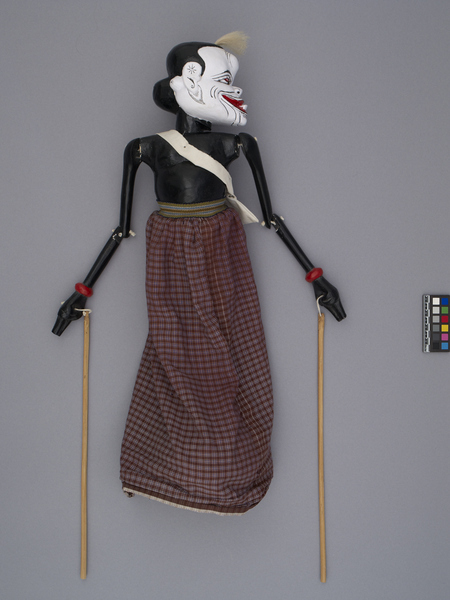Rod Puppet Item Number: 2872/32 a-c from the MOA: University of British Columbia



Description
Panakawan puppet named Semar. The head (part a) has a white face with protruding bumps behind each ear and in the middle of the forehead. The eyes are partially open and have red pupils. Below the small nose is an open smiling mouth with one white tooth protruding from the lower gum. The lower lip protrudes out past the upper, which is lined with a small black moustache. A tuft of fibre hair sticks out of the top of the head, and the black painted hair is gathered at the back of the head in a bun. The torso (part b) is uncovered and painted black. There is a bulge between the shoulders at the back, and to the front are a plump pectoral area and a bulging belly. A white bag with a strap is draped horizontally across the chest. A checked sarong with a green waistband falls past the puppet’s feet and hides a removable wooden stick, embedded in a white wooden base, (part c) that extends through the torso to control the movement of the head. The arms are moveable at shoulder and elbow by wooden sticks attached to each hand. Red bracelets surround each wrist. The thumb and third and fourth fingers of each hand are curled into the palm, while the first and second fingers remain straight.
History Of Use
Panakawan puppet from Indonesian wayang (stage plays). The Panakawan puppets are “clown-servants”, providing comic relief and commentary and acting as aids and advisors to the hero of the play. They represent common villagers. This puppet is named Semar, who, as well as a clown-servant, is also a deity.
Item History
- Made in West Java, Indonesia
- Collected between 1990 and 1999
- Owned by Betty Cairney
- Owned by Jack Cairney before March 15, 2011
- Received from Jack Cairney (Donor) on March 15, 2011
What
- Name
- Rod Puppet
- Identification Number
- 2872/32 a-c
- Type of Item
- puppet
- Material
- wood, cotton fibre, paint and plastic fibre ?
- Overall
- height 57.5 cm, width 17.0 cm, depth 33.0 cm
Who
- Culture
- Sundanese
- Previous Owner
- Betty Cairney and Jack Cairney
- Received from
- Jack Cairney (Donor)
Where
- Holding Institution
- MOA: University of British Columbia
- Made in
- West Java, Indonesia
When
- Collection Date
- between 1990 and 1999
- Ownership Date
- before March 15, 2011
- Acquisition Date
- on March 15, 2011
Other
- Condition
- good
- Current Location
- Case 61
- Accession Number
- 2872/0032 a-c